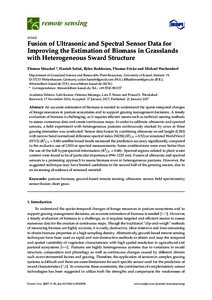Fusion of Ultrasonic and Spectral Sensor Data for Improving the Estimation of Biomass in Grasslands with Heterogeneous Sward Structure
| dc.date.accessioned | 2017-06-26T13:52:55Z | |
| dc.date.available | 2017-06-26T13:52:55Z | |
| dc.date.issued | 2017-01-21 | |
| dc.identifier.issn | 2072-4292 | |
| dc.identifier.uri | urn:nbn:de:hebis:34-2017062652843 | |
| dc.identifier.uri | http://hdl.handle.net/123456789/2017062652843 | |
| dc.description.sponsorship | Gefördert durch den Publikationsfonds der Universität Kassel | |
| dc.language.iso | eng | |
| dc.rights | Urheberrechtlich geschützt | |
| dc.rights.uri | https://rightsstatements.org/page/InC/1.0/ | |
| dc.subject | pasture biomass | eng |
| dc.subject | ground-based remote sensing | eng |
| dc.subject | ultrasonic sensor | eng |
| dc.subject | field spectrometry | eng |
| dc.subject | sensor fusion | eng |
| dc.subject | short grass | eng |
| dc.subject.ddc | 630 | |
| dc.title | Fusion of Ultrasonic and Spectral Sensor Data for Improving the Estimation of Biomass in Grasslands with Heterogeneous Sward Structure | eng |
| dc.type | Aufsatz | |
| dcterms.abstract | An accurate estimation of biomass is needed to understand the spatio-temporal changes of forage resources in pasture ecosystems and to support grazing management decisions. A timely evaluation of biomass is challenging, as it requires efficient means such as technical sensing methods to assess numerous data and create continuous maps. In order to calibrate ultrasonic and spectral sensors, a field experiment with heterogeneous pastures continuously stocked by cows at three grazing intensities was conducted. Sensor data fusion by combining ultrasonic sward height (USH) with narrow band normalized difference spectral index (NDSI) (R^2CV = 0.52) or simulated WorldView2 (WV2) (R^2CV = 0.48) satellite broad bands increased the prediction accuracy significantly, compared to the exclusive use of USH or spectral measurements. Some combinations were even better than the use of the full hyperspectral information (R^2CV = 0.48). Spectral regions related to plant water content were found to be of particular importance (996–1225 nm). Fusion of ultrasonic and spectral sensors is a promising approach to assess biomass even in heterogeneous pastures. However, the suggested technique may have limited usefulness in the second half of the growing season, due to an increasing abundance of senesced material. | eng |
| dcterms.accessRights | open access | |
| dcterms.bibliographicCitation | In: Remote Sensing. - Basel : MDPI. - 2017, 9(1), 98 | |
| dcterms.creator | Moeckel, Thomas | |
| dcterms.creator | Safari, Hanieh | |
| dcterms.creator | Reddersen, Björn | |
| dcterms.creator | Fricke, Thomas | |
| dcterms.creator | Wachendorf, Michael | |
| dc.relation.doi | doi:10.3390/rs9010098 |
Dateien zu dieser Ressource
Das Dokument erscheint in:
-
Publikationen [9]
-
Artikel [1105]

